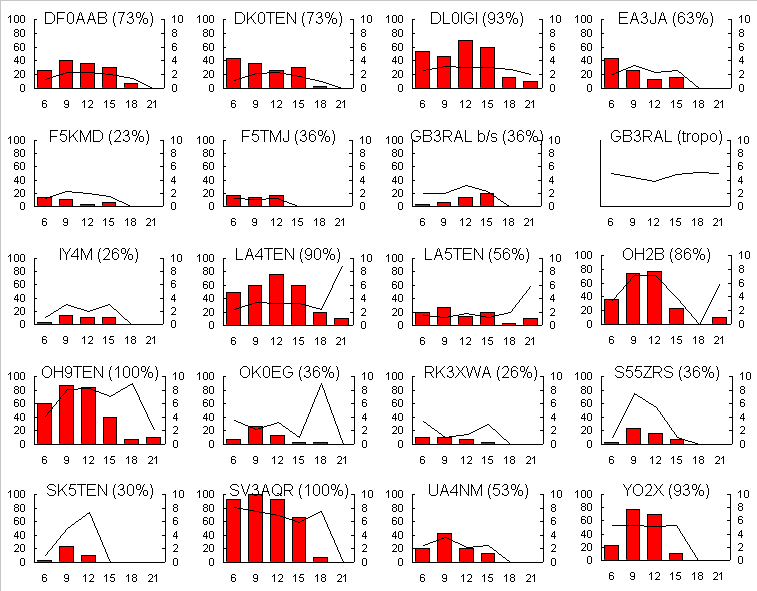Reliability and Strength of European Beacons
Reported in the UK during November 2000
| The following graphs depict reliability and signal strength of all European beacons heard by members of the Six and Ten Reporting Club in the UK during November 2000. Compare these results with those collected two months before in September 2000. Also check out the tables showing average reliability of European beacons in the UK in the first half of 2000.
These beacons were heard via a complex mixture of normal F2 propagation, F2 backscatter, sporadic E and auroral E, as detailed in the propagation explanation below. A legend is also provided for these graphs. |

| Beacon graphs legend: Graph bars (in red; left side Y-axis): beacon reliability as the percentage of days a beacon was heard by any (UK) observer within each time band. Graph lines (right side Y-axis): signal strength calculated as the average of the daily maximum signal reported by any observer in each time band. Time band codes (X-axis): 6=0600-0900, 9=0900-1200, 12=1200-1500, etc. Times in UT (GMT). Titles are beacon callsigns followed by the daily reliability figures, the percentage of days for the month on which the beacon was reported. |
| Propagation Involved (from the Six and Ten Report, November 2000): The main feature of inter-European propagation in November was the high reliability of backscatter signals. The following beacons were largely or entirely heard by this mode: DF0AAB, DK0TEN, DL0IGI, EA3JA, F5KMD, F5TMJ, GB3RAL (b/s), IY4M, LA4TEN, LA5TEN, OK0EG, S55ZRS, and SK5TEN. Backscatter was sometimes quite loud with a lot of echo making copy difficult.
Normal F-layer propagation was responsible for the reception of OH2B, OH9TEN, RK3XWA, SV3AQR, UA4NM and YO2X. Minor backscatter contributions were noted in the results for OH2B and OH9TEN at times when the F-layer skip distance was too long - i.e. before and after direct skip openings, and on days when ionisation was insufficient. High strength signals from SK5TEN and S55ZRS heard in western England might also be direct short-skip F-layer. There was a small amount of sporadic E identified and this accounts, for example, for the strong signals recorded for OK0EG in the 18z period. Auroral E was the cause of some late evening propagation, as seen best in the results for the 21z period for the LA and OH beacons. There was also auroral E after midnight not displayed in these graphs. |